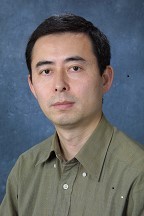| Professor Kang Li |
| Fri 08 Sep 2017, 13:30 - 14:30 |
| LT1, Sanderson Building |
If you have a question about this talk, please contact: Francisco Garcia Garcia (fgarcia2)

Abstract
The formation process and morphology of micro-structured ceramic hollow fibre membranes have been studied. Experimental results obtained so far indicate that two types of membrane morphologies, i.e. micro-channel and packed pore network structures can be expected as shown in Figure 1. The formation of these structures in ceramic membranes is due to the hydrodynamically unstable viscous fingering induced phase inversion, developed when a less viscous fluid (non-solvent) is in contact with a higher viscosity fluid (ceramic suspension containing invertible polymer binder). When the rate of viscous fingering is faster than that of the phase-inversion, micro-channels are obtained; otherwise, a 3D network pore structure is prevailed.
To better understand the relationship between non-solvent concentration in the spinning suspension and viscosity, with regard to membrane morphologies, the two parameters have been varied systematically so as to determine the dominating factor, while dynamic video-microscopy has been employed to visualize the formation of the micro-channels. In addition to the high quality single-layer hollow fibre membranes prepared, dual-layer or even triple-layer ceramic composite hollow fibre membranes with controllable morphology and microstructure have also been developed for intermediate temperature solid oxide fuel cell (SOFC) and compact hollow fibre membrane reactor for methane conversion. Finally, use of the developed ceramic hollow fibre membrane as a support for the further development of a catalytic convertor for car emission control will be briefly discussed.
Bio
Professor Kang Li has been a Professor of Chemical Engineering at Imperial College London since 2007. Currently, he leads a research group (12 post-docs/PhDs) at Imperial to conduct multidisciplinary research in membrane science, solid oxide fuel cells, wastewater treatment, membrane catalysis, separation processes and reaction engineering. He received Rector's Award and Research Excellence Award at Imperial in 2007 and MND R&D Award 2013, Singapore. His commitment to working at interdisciplinary boundaries is evidenced by his involvements as an editor in Current Opinion in Chemical Engineering, Elsevier (Chemical Engineering), as an editorial board member of Journal of Membrane Science, Elsevier (Membrane Technology) Journal of Chemical Technology and Biotechnology, Wiley (Chemical Technology) and Polymers, MDPI, Switzerland (Polymer Science) and as a guest editor in Reactive and Functional Polymers, Elsevier (Functional Polymers) and International Journal of Hydrogen Energy, Elsevier (Energy). He has published extensively in international referred journals (cited over 11300 times) with h-index of 58 (Google Scholar) and has authored a book on Ceramic Membranes for Separation and Reaction (Wiley 2007). Kang Li has been named as one of most cited researchers in Chemical Engineering by Shanghai Jiaotong University (http://www.shanghairanking.com/The-Most-Cited-Researchers-Developed-for-ShanghaiRanking-Global-Ranking-of-Academic-Subjects-2016-by-Elsevier.html).


